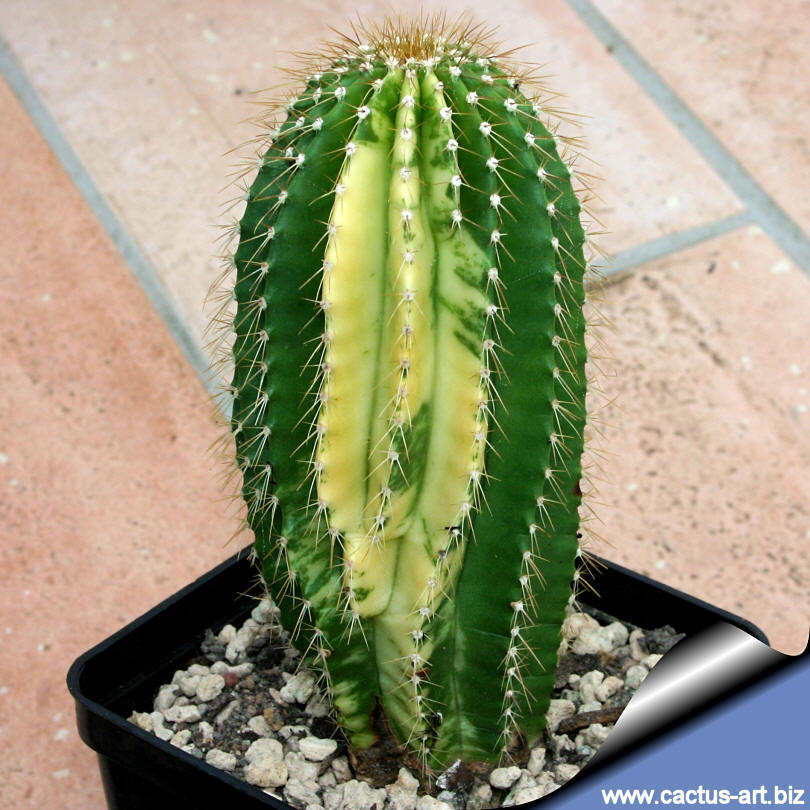|
|
|

Neobuxbaumia
polylopha forma variegata
This plant is very rare and
priced in cultivation. A large well grown variegate Neobuxbaumia is
truly an achievement.
|
|
Description: Very tall columnar cactus with a
thick telephone pole-like stem , 7-12(-15) m tall; Often remain solitary
but it can ramify forming a candelabra-like tree with little curved
branches. This plant is characterized by the many, narrow, closely
spaced ribs
Stem: Thick, columnar, deeply ribbed, green.
Ribs: 10-30 narrow, acute
Areoles: Small , 4-6 mm apart with yellowish felt
Spines: Yellowish turning grey as they age, thin, acicular,
bristle-like, mostly pointing downward, approx 1 to 2 cm long.
As ages, spines tend to fall
out.
Central spines: 1
Radial spines: 4 - 8
Flowers: Diurnal, externally green with vivid pink, dark red or
magenta (or orage-yellow) petals near the top of the cactus, their ovary
is sometimes tuberculate, with small scales and red filaments.
Fruits: Small, cylindrical, greenish approx 4 cm long. They
mature rapidly and the seeds can be ready to germinate in only 3 weeks.
They open in a quite peculiar way and form something like a star on the
stem of the plant with the black seeds in contrast with the off-white
colour of the pulp. The fruits are totally exposed to the birds that
devour them quickly. They are also edible for humans, tastes smoothly
sweet and remembers a very mature plum.
|
|


Advertising
|
|
|
|
|
Family:
Cactaceae (Cactus
Family)
Scientific name: Neobuxbaumia polylopha (DC)
Backeberg
Place of publication: Blätt. Kakteenf. 1938(6): [24].
1938
forma variegata
Origin: Mexico (endemic to a small area in the state of
Guanajuato, Hidalgo, Querétaro, San Luis Potosí)
Habitat: The Neobuxbaumia polylophas grow
in limestone canyon wall, where they emerge majestically from the thorny
forest, in this area there are several columnar species.
Conservation status: Listed in
CITES appendix 2.
Common Names include: (English) Golden Saguaro,
Golden-spined saguaro, Wax cactus, Cone cactus, (Mexican) Cardón.
Etymology: The species name "polylopha"
means "many ribs"
Synonyms:
- Cereus polylophus DC. (Basyonym)
Place of publication:
Mém. Mus. Hist. Paris, 17 : 115, 1828
- Pilosocereus polylophus (DC.)
Salm Dyck
Place of publication:
Cact. Hort. Dyck. 1844 : 24, 1845
- Cephalocereus polylophus (DC.)
Br. et R.
Place of publication:
Contr. U.S. Nat. Herb., 12 : 419, 1909
- Carnegia polylopha (A.P.de
Candolle) D.R.Hunt 1988
|
|
|
|
Culture: Neobuxbaumia are of easy culture and
can grow 15-20 cm a year. They
are cold intolerant. Make sure they are not
exposed to freezing temperatures ( Hardy to -2°C) or they may die. They
need
a well drained soil mix. It appreciates abundant water during the
summer and, during its growing period but allow to
dry fully before watering again, it is possible to add a
fertilizer 6-6-18 from time to time. During the
winter months they should be rather kept dry. Since they are rapid
growers, they need plenty of space for their roots. Repotting should be
done every other year, or when the plant has outgrown its pot. Sun
Exposure: Light shade when young, full sun later. In mild climate they
can be grown in rock gardens in full sun, in dry and sandy
soils.
Special cares for
variegated forms: In the
summer it is best to avoid direct sun during the hottest hours of
the day (but they benefits from morning sun, that helps to produce
strong and colourful spines). In case of cultivation in
full sun it is best to plant with the variegated spot facing
northeast, so it gets the least amount of direct sunlight as possible.
Propagation: Usually by
Seeds (Seeds should be sown in a well-drained soil mix. Surface sowing
is the best; seeds germinate in 14-28 days at 25° C, or from
cuttings in spring (let them dry till the ends callous well). Then
replant them in fresh cactus soil that is ever so slightly moist, and
keep it that way till they root)
Variegated Neobuxbaumia are very rare and priced
in
cultivation. All variegates are
mutants. Something has gone wrong with the cellular structure of the
growth tip (apical
meristem) of the plant. As a result of this mutation,
chlorophyll is missing from some or all layers of the plant
epidermis. The odd variegate appears in many seedling batches in a
small percentage, and is generally separated from normal plants.
Variegated plants grow more slowly, and are generally smaller than
non-variegates of the same species. Coloured areas are also generally
weaker, and more
susceptible to
fungus,
sunburn and other defects. A large well grown variegate
Neobuxbaumia
is truly an achievement. These are harder to grow well than they appear. |
|
Photo of conspecific taxa, varieties, forms and
cultivars of Neobuxbaumia polylopha.
|
|